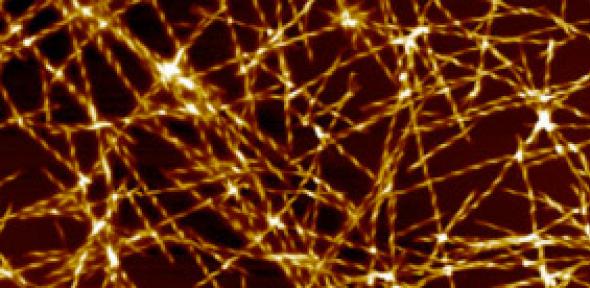
Cambridge chemists have made a breakthrough in understanding the onset of Alzheimer’s disease. Tuomas Knowles, Chris Dobson and colleagues have identified the pathway by which the aberrant proteins that cause Alzheimer’s are formed.
Protein molecules are made by joining amino acids together in the order encoded in our DNA. These proteins are long, thin chains, which are then folded up into complex secondary structures that enable them to carry out their biological functions. However, sometimes this folding process goes wrong.
The misfolded proteins can catch normal proteins, clumping together into amyloid fibrils, which can contain millions of non-functioning protein molecules. These fibrils can continue to grow, forming the plaques that are found in the brains of Alzheimer’s patients.
Until now, the mechanism by which the plaques formed was unknown. Work in Cambridge chemistry, much of it carried out by PhD student Samuel Cohen, shows that once a small but critical level of malfunctioning protein clumps has formed, a runaway chain reaction is triggered. This multiplies exponentially the number of protein composites.
A secondary nucleation process leads to the formation of more small clusters of a few protein molecules. These toxic oligomers travel dangerously around the brain cells, killing neurons and, ultimately, causing loss of memory and the other symptoms of dementia.
‘We are essentially using both physical and chemical methods to address a biomolecular problem, mapping out the networks of processes and dominant mechanisms to recreate the crime scene at the molecular root of Alzheimer’s disease,’ Tuomas says.
‘Increasingly, using quantitative experimental tools and rigorous theoretical analysis to understand complex biological processes are leading to exciting and game-changing results. With a disease like Alzheimer’s you have to intervene in a highly specific manner to prevent the formation of the toxic agents. Now we’ve found how the oligomers are created, we know what process we need to turn off.’
The findings may pave the way for earlier diagnosis of Alzheimer’s, and other neurological disorders such as Parkinson’s that result from misfolded proteins. It may even open up possibilities for a new generation of drugs, as this is the earliest stage of the development of Alzheimer’s that drugs might target.
S.I.A. Cohen, S. Linse. L.M. Luheshi, E. Hellstrand, D.A. White, L. Rajah, D.E. Otzen, M. Vendruscolo, C.M. Dobson and T.P.J. Knowles, Proc. Natl Acad. Sci. Early Edition, published online 20 May 2013; www.pnas.org/cgi/doi/10.1073/pnas.1218402110
